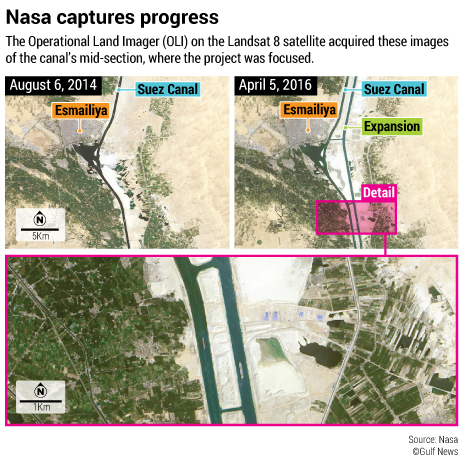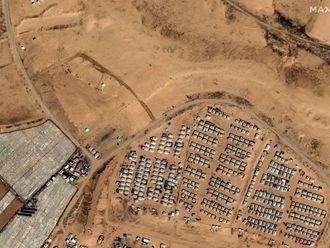Cairo: Less than two months after he took office in June 2014, Egyptian President Abdul Fattah Al Sissi unveiled a plan to construct an extension to the historical Suez Canal, an artificial short cut linking the Mediterranean and Red seas. At the time, he ordered that the 35-kilometre stretch be built in a record one year. And it happened.
The eight-billion-dollar project was wholly funded by Egyptians through certificates of deposits, reflecting popular support for the new leader.
In August 2015, the “new Suez Canal” was inaugurated at a grand ceremony attended by world leaders and dignitaries.
The scheme marked the first in a series of mega-projects initiated by Al Sissi to revitalise the Egyptian economy battered by years of unrest.
The two-direction extension runs parallel to the original 193-kilometre canal that connects Asia and Europe.
It also cuts the waiting time for ships passing through the vital waterway to three hours instead of eight to 11 hours.
Moreover, with the new route in operation, transit times through the Suez Canal have dropped to 11 hours instead of 18 hours.
The new expansion allows the canal, a key foreign currency earner for Egypt, to accommodate more and larger ships.
The government has said that the “new Suez Canal” will increase annual revenues from the current $5.2 billion to around $13.2 billion by the year 2023.
It also increases the daily average of transiting vessels to 97 ships by the year 2023, up from 49 ships on the old canal.
The major overhaul has furthermore provided direct non-stop transit for 45 ships in the two directions.
The first months that followed the inauguration of the expansion have not lived up to expectations, though.
Revenues from the Suez Canal reached $5.17 billion in 2015 against $5.46 billion the previous year, according to official figures.
The vessels using the waterway during that year reached 17,483, an increase of 2 per cent compared to 2014.
The drop in receipts is mainly attributed to the dramatic fall in oil prices since mid-2015 and a slow global trade, according to experts.
The plunge in crude prices has prompted the Suez Canal operator to offer cuts in tolls for long-haulage vessels in order to attract them to use the shipping route.
“It is unfair to judge the new Suez Canal at present,” said Jalal Al Deeb, an ex-adviser to the head of the Suez Canal Authority.
“Its impact on the waterway’s revenues will be seen by the year 2020 when the Suez Canal Corridor Project goes into operation,” he told private newspaper Al Masry Al Youm.
Al Deeb was referring to a multi-billion-dollar ambitious development scheme designed to turn Egypt into a global trade and logistics hub. The large-scale project features ports, agro-industrial ventures and rail routes. It is also projected to generate millions of jobs for the country’s 90 million population. Egypt’s unemployment rates stand at 12.8 per cent, according to government figures.
The original Suez Canal has been a key world shipping route since its inauguration in 1869. It stretches from the City of Port Saeed on the Mediterranean Sea to the Port of Suez on the Red Sea.
When built, it was 164 kilometres long and eight metres deep. Upgrade works have since expanded it.
In 1956, the then Egyptian president Jamal Abdul Nasser nationalised the Suez Canal to use its revenues in constructing the High Dam in Upper Egypt. The move prompted Britain, who controlled the channel, to join forces with France and Israel and waged tripartite attacks on Egypt marking the climax of what came to be known as the Suez Crisis.
The turmoil forced the closure of the canal until 1957.
It was again shut down for eight years in the wake of the 1967 Middle East War with Israel.
In June 1974, the then Egyptian president Anwar Sadat re-opened the canal for navigation and it has since experienced several overhauls, culminating in the latest expansion.
With this in mind, for Egyptians the 147-year-old Suez Canal is not just a main source of national income. An estimated 240,000 of Egyptian labourers, who worked under servitude-like circumstances, perished during its 10-year construction that began in 1859.
No wonder, the canal is a principal maker of Egypt’s eventful modern history.













